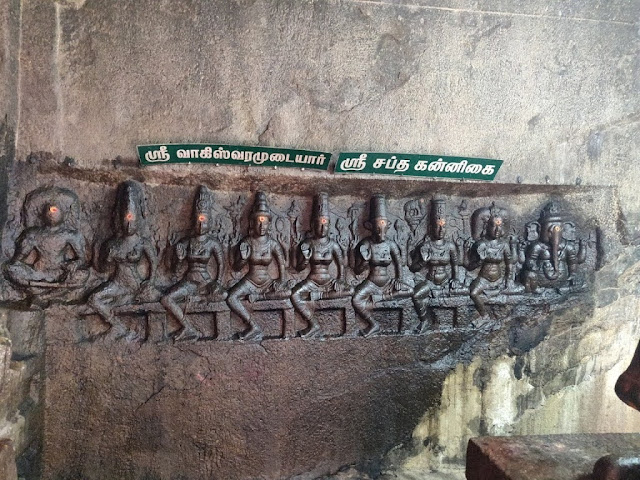Vahisvaramudayar Temple,
Malayadipatti – The Temple
This cave temple is excavated on the northern façade of the hill. This cave temple is situated little higher to the Vishnu cave temple on the eastern end of the hill. The cave is facing towards north, but the sanctum is facing towards west. The cave temple consists of sanctum, ardha mandapam and mukha mandapam. Both the sanctum and ardha mandapam are excavated on the hill and the mukha mandapam is later structural addition to the cave shrine.
The ardha mandapa is facing towards north while the entrance of the mukha mandapa is facing towards west. The mukha mandapa might have been constructed during Vijayanagara period. There are few Chola era inscriptions on the exterior of the northern wall. There is a 9th century inscription dated to Chola King Aditya Chola I in the interior of the western wall. There are four slender pillars of Vijayanagara architectural style can be seen inside the mukha mandapa.
A shrine is formed by connecting two rear pillars with an arch. This shrine enshrines the images of Lord Murugan and Ganesha. The ardha mandapam measures 12.5 feet long and 13.5 feet wide. The ardha mandapa is supported by two pillars and two pilasters of Mahendra style. Nandi, housed on a raised platform can be seen in the ardha mandapam, facing towards the sanctum. The Nandi and the platform is carved out of the mother rock.
Idols of Vinayaga and Murugan can be found in the ardha mandapam. The sanctum measures 7 feet long, 7 feet wide and 7 feet high and can be accessed through flight of four steps from ardha mandapam. The sanctum enshrines the presiding deity, Vagishvara / Alathurai Mahadevar in the form of Lingam on a circular pitha. The present Linga and pitha were later addition as the original Linga carved from the mother rock was destroyed. The dvarapalas are shown in the niches, formed between the pilasters on either side of the entrance of the sanctum.
Both the dvarapalas are two armed. The dvarapala on the left niche represents trisula (trident) and the dvarapala on the right niche represents Mazhu (axe). Both the dvarapalas are standing in similar posture with one of their hand is resting on the club and the other hand of the left side dvarapala is in tarjani mudra (one finger pointing upwards) & the other hand of the right side dvarapala is raised upwards in vismaya mudra (astonishing posture). There is a snake seen above the shoulders on both the dvarapalas.
There are three bas relief sculptures on the western lateral wall of the ardha mandapa. Sculpture of Durga standing over a lotus pedestal can be seen on northern corner of the bas relief. She is eight armed holding several weapons. The front two hands carry a (trident) which is pointed towards a figure probably Mahishasura shown on left side of the goddess. One of her leg is slightly bent and placed beside her straight leg planted over the pedestal.
Her mount, lion, is shown on her right side just adjacent to Harihara image. It is shown in rampant posture with open mouth. There are two devotees seated on the ground on either side. The central sculpture in the bas relief is Hari-Hara, combined form of Vishnu and Shiva. The left side of the sculpture represents Lord Vishnu and the right side represents Lord Shiva. He is four-armed. His upper hands holds shankha (conch) and parashu (axe).
One of his lower hand is resting over waist while the other shows abhaya mudra. There are two flying figures probably Suryan and Chandran on the top corners of the sculpture. There are two devotees on either side. Both the devotees are holding a flower in one of their hands. The southern corner sculpture represents Brahma Sastha, a form of Lord Murugan. He is depicted with four arms. His upper hands holds spear and akshamala. One of his lower hand is resting over his waist while the other shows abhaya mudra.
Sculptures of Saptamatrikas flanked with Ganesha and Veeerabadhra can be seen on the southern lateral wall of the ardha mandapa. The relief starts with Veerabhadra on the eastern end and ends with Ganesha on the western end. All the images except Veerabhadra are shown seated in sukhasana with one leg folded & placed on the seat while the other leg hanging & resting on the ground. Veerabhadra is shown seated with both legs placed on the seat and joined with a Yogapatta.
All the images are depicted with four arms. Each Matrikas are depicted with their respective flags behind them. There is another bas relief figure of Chandikeswara on the on the northern wall. He is shown two-armed carrying his axe. There are two later period structures in the temple complex. The structure found in the northwest corner is Madapalli (temple kitchen). The structure found on the northeast corner is the shrine for the goddess Vadivulla Mangai. Both the goddess shrine and Madapalli are facing towards south.
The goddess shrine consists of sanctum and mukha mandapam. The sanctum enshrines an image of Vadivulla Mangai. She is in standing posture. She is four armed. Her upper hands holds lotus and the lower hands shows abhaya and varada mudra. A sculpture of Nardana Ganapathy can be seen in the mukha mandapam. There are remains of a ruined compound wall for this temple complex. The compound wall extends up to the structural shrine in the northwest and for the remaining portion is left with the basement only.


.jpg)




.jpg)
.jpg)

.jpg)
